
New Vernon is an unincorporated community and census-designated place (CDP) in Harding Township, Morris County, New Jersey, United States. New Vernon is the location of the governmental offices for Harding Township. As of the 2020 census, the population of New Vernon was 825.

William Howard Taft National Historic Site is a historic house at 2038 Auburn Avenue in the Mount Auburn Historic District of Cincinnati, Ohio, a mile (1.6 km) north of Downtown. It was the birthplace and childhood home of William Howard Taft, the 27th president and the 10th chief justice of the United States. It is a two-story Greek Revival house built circa 1845.
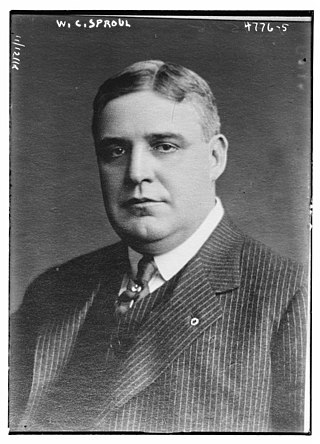
William Cameron Sproul was an American politician from Pennsylvania who served as a Republican member of the Pennsylvania State Senate from 1897 to 1919 and as the 27th governor of Pennsylvania from 1919 to 1923. He also served as chair of the National Governors Association from 1919 to 1922.

The Harding Home is a historic house museum at 380 Mount Vernon Avenue in Marion, Ohio. It was the residence of Warren G. Harding, 29th president of the United States. Harding and his future wife, Florence, designed the Queen Anne Style house in 1890, a year before their marriage. They were married there and lived there for 30 years before his election to the presidency.
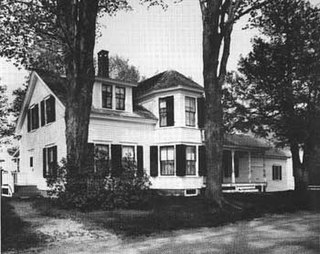
The Coolidge Homestead, also known as Calvin Coolidge Homestead District or President Calvin Coolidge State Historic Site, was the childhood home of the 30th president of the United States, Calvin Coolidge and the place where he first took the presidential oath of office. Located in Plymouth Notch, Vermont, Coolidge lived there from age four in 1876 to 1887, when he departed for Black River Academy for education. He is buried in Plymouth Notch Cemetery not far from the home.
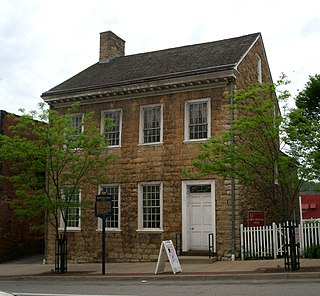
The David Bradford House is a historic house museum at 175 South Main Street in Washington, Pennsylvania. Completed in 1788, it was the home of David Bradford, a leader of the Whiskey Rebellion. It has both architectural and historic importance, and was designated a National Historic Landmark in 1983. It is open weekly between April and November, or by appointment.

The Hoover House, formally known as the Lou Henry Hoover House or the Lou Henry and Herbert Hoover House, is a historic house located on the campus of Stanford University in Stanford, California, United States. Completed in 1920, it is the former house of Herbert Hoover, 31st president of the United States, and his wife Lou Henry Hoover, who designed it. It is now the official home of the president of Stanford. In addition to its importance as a residence of the Hoovers, the house is a significant early example of the International Style of architecture. It was designated a National Historic Landmark in 1985.

The Clinton House is an 18th-century Georgian stone building in the city of Poughkeepsie, Dutchess County, New York, United States. It is a New York State Historic Site and has been listed in the National Register of Historic Places as a historic place of local significance since 1982. The house was named for George Clinton, who served as the first Governor of New York and fourth Vice-President of the United States. He was believed to have lived there after the American Revolutionary War, but it is now known that it was never his residence.
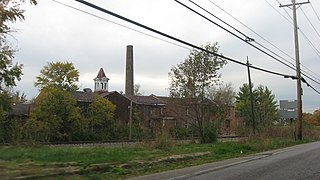
The Harding-Jones Paper Company District is a registered historic district in Excello, Ohio, listed in the National Register of Historic Places on May 29, 1975. A significant, early example of Ohio industry, the mill was owned by the Harding and Jones families for most of its operation. The mill, adjacent to the first lock completed on the Miami-Erie Canal, also includes two residences, a carriage house, and a canal lock.

The Chester Harding House is an historic building located at 16 Beacon Street in Boston, Massachusetts, United States, across from the Massachusetts State House on Beacon Hill. It was designated a National Historic Landmark in 1965 for its association with the noted portraitist Chester Harding, whose home it was from 1826 to 1830. The building has since 1963 been home to the Boston Bar Association.

Prospect House, known also as just Prospect, is a historic house on the Princeton University campus in Princeton, New Jersey, United States. Built in 1851, it is a fine example of the work of architect John Notman who helped popularize Italianate architecture in America. Notable residents include Woodrow Wilson during his tenure as president of the university. The building now serves as a faculty club. It was designated a National Historic Landmark in 1985 for its architecture and historic associations.

Rosedale Park is a historic district located in Detroit, Michigan. It is roughly bounded by Lyndon, Outer Drive, Grand River Avenue, Southfield Freeway, Glastonbury Avenue, Lyndon Street and Westwood Drive. It was listed on the National Register of Historic Places in 2006. The Rosedale Park district has the largest number of individual properties of any district nominated to the National Register of Historic Places in Michigan, with 1533.
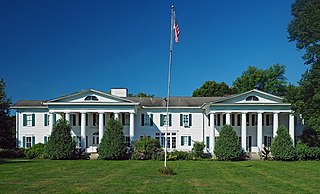
The Cordenio Severance House is a mansion in Cottage Grove, Minnesota, United States, built for attorney Cordenio Severance (1862–1925). The mansion, also known as Cedarhurst, was first built as a simple country farm house shortly after the American Civil War. It was expanded in 1886 to serve as the summer residence of the Severance family. Between 1911 and 1917, additions designed by architect Cass Gilbert expanded the house into a mansion with 12,000 square feet (1,100 m2) and 26 rooms. The Cordenio Severance House was listed on the National Register of Historic Places in 1976 for its local significance in the themes of architecture and law. It was nominated for its association with Cordenio Severance, a leading attorney in Saint Paul, Minnesota, from 1887 to the 1920s, and for being an example of a grand country estate. The mansion now serves as an event venue.

The Grover Cleveland Birthplace is a historic site located at 207 Bloomfield Avenue in Caldwell, Essex County, New Jersey, United States. It is the only house museum dedicated to U.S. President Grover Cleveland.

The Harvey H. Cluff house is a house in central Provo, Utah, United States, built in 1877 that is on the National Register of Historic Places. It was originally owned by Harvey H. Cluff.

Lieutenant General George Washington is an 1860 equestrian statue of George Washington, at Washington Circle, at the edge of the George Washington University's campus, in Washington, D.C. The statue was sculpted by Clark Mills, who also created the equestrian statue of Andrew Jackson in front of the White House. The traffic circle where the statue is located was one of the original city designs by Pierre Charles L'Enfant. The statue and surrounding park are in the Foggy Bottom neighborhood at the intersection of 23rd Street, New Hampshire Avenue, and Pennsylvania Avenue NW. The K Street NW underpass runs beneath the circle.

The R. B. and Lizzie L. Louden House, also known as the William and Susan F. Elliott House and the John and Gladdy Ball House, is a historic residence located in Fairfield, Iowa, United States.

The Harding Railroad Car is a historically significant Pullman railroad passenger car located at Pioneer Park in Fairbanks, Alaska. Also called Denali, and designated with equipment number X-336 by the Alaska Railroad, the car was one of three used to carry a delegation that included President Warren G. Harding in 1923 to the Mears Memorial Bridge for a ceremony marking completion of the railroad between Fairbanks and Seward. The car was purchased by the Alaska Railroad in 1923 from the Great Northern Railroad, and was used in its service until 1945. At the urging of the Fairbanks "igloo" (chapter) of the Pioneers of Alaska, the car was restored in 1959–60 and given to the city of Fairbanks. It was placed in Alaskaland in 1967, created to mark the centennial of the Alaska Purchase. It was used for some years as the park's visitor center.
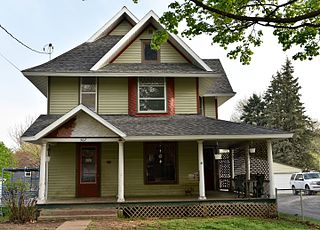
The William A. and Ida C. Johnson House is a historic residence located in Oskaloosa, Iowa, United States. The Johnsons, who were farmers, moved to town so that their children could attend Quaker schools there. This was typical of many Quaker families of that era. Other family members also boarded with them so they too could attend the schools. William Johnson also served on the William Penn College Board of Trustees and served as its president from 1915 through 1922. It was during his tenure that the Main Building was destroyed by fire and the college moved to its present location. This Queen Anne style house is a 2½-story, frame, single-family dwelling. It features a wrap-around full-width porch with a gable-end entryway and a bay window on the main facade. The house is capped with a complex roof of intersecting steeply-pitched gables. It is the Johnsons' association with the school in the context of the Quaker testimony in Oskaloosa that makes this house historic. It was listed on the National Register of Historic Places in 1996.





















